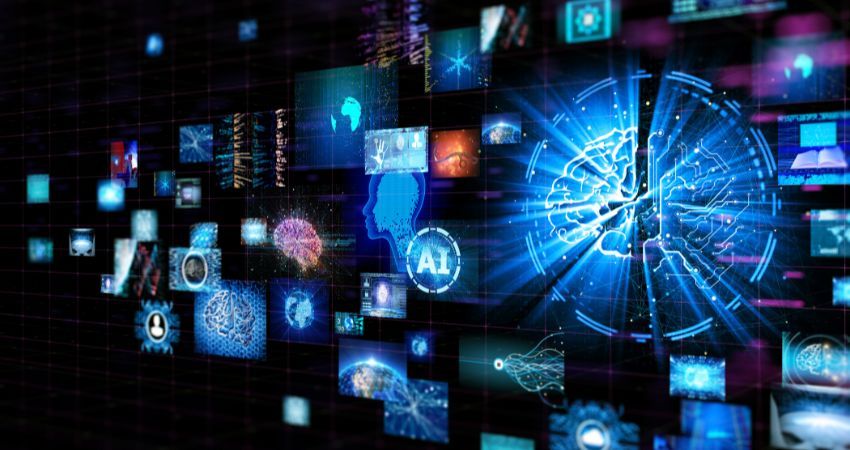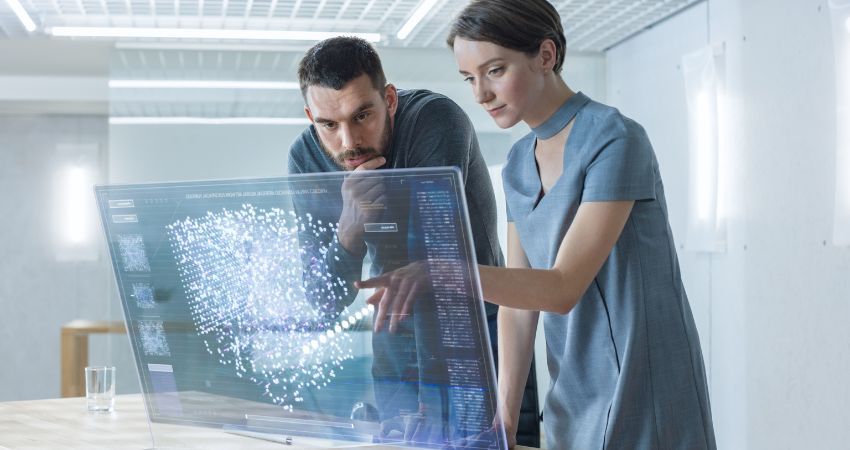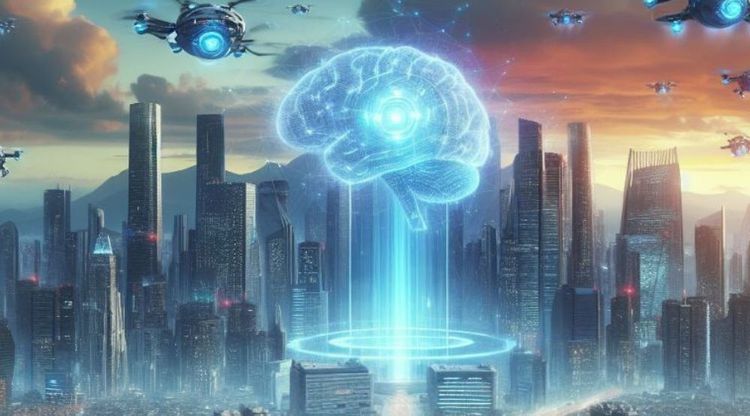The application of image AI spans diverse areas, including computer vision, medicine, security, industrial automation, entertainment and more.
Constant advancement in this field has resulted in significant improvements in image-based technologies and services, transforming the way we interact with the visual world around us.
Keep in mind that imaging Artificial Intelligence (AI) is a fascinating field that focuses on developing systems capable of handling imaging-related tasks.
These tasks range from object recognition and image classification to pattern detection and image segmentation.
The core of these systems often lies in advanced deep learning algorithms, notably convolutional neural networks (CNNs), designed to process and analyze visual data in a similar way to the human brain.
By training on large image datasets, these networks learn relevant patterns and features that drive a wide range of applications, such as facial recognition, image classification, and generating new realistic images.
Check out more about image AI below:
What is Image AI?

Image AI refers to Artificial Intelligence (AI) systems that are developed to handle image-related tasks.
These tasks may include object recognition, image classification, pattern detection, image segmentation, among others.
Image AI systems often involve the use of deep learning algorithms, especially convolutional neural networks (CNNs), which are designed to process and analyze visual data in a similar way to the human brain.
These networks are trained on large image datasets to learn relevant patterns and features.
Some examples of image AI applications include:
- Facial Recognition: Identify and recognize faces in images or videos.
- Image Classification: Assign labels or categories to images based on visual content.
- Object Detection: Identify and locate specific objects within an image.
- Image Segmentation: Divide an image into segments or regions with similar characteristics.
- Image Generation: Create new realistic images based on patterns learned during training.
- Sentiment Analysis in Images: Determine the emotions or feelings portrayed in an image.
Image AI is widely used in many areas, such as computer vision, medicine, security, industrial automation, entertainment, and more.
Continued advancement in this area has led to significant improvements in various image-based technologies and services.
What is image generator AI for?
An image-generating Artificial Intelligence (AI) system is designed to create images autonomously.
These systems use advanced machine learning techniques such as Generative Neural Networks (GANs) to produce realistic new images based on the data they were trained with.
Here are some of the applications and purposes for which image-generating AIs are used:
Creative Content Generation
AIs can create artwork, graphic design, illustrations, and other types of visual content. Artists and designers can use these tools to gain inspiration or as a starting point for their own creations.
Image Enhancement
They can be used to improve the quality of images, such as increasing resolution, removing noise or colorizing black and white photos.
Character and Environment Creation
In video games, cinema, animation and other forms of entertainment, AIs can generate characters, settings and visual elements. This can speed up the development process and provide creative variations.
Design Prototyping
In product design, architecture, and other disciplines, AIs can generate visual prototypes based on provided specifications, enabling rapid iteration and visualization of ideas.
Simulation and Training
In machine training, image-generating AIs can create synthetic datasets to train models for computer vision, object recognition, or other systems that rely on visual data.
Content Personalization
In advertising or content platforms, image AIs can generate personalized images based on the user profile, improving relevance and engagement.
Augmented Reality (AR)
In AR environments, AIs can generate visual elements to overlay on the real world, creating immersive and interactive experiences.
Medicine and Biological Sciences
In medicine, AIs can generate synthetic medical images to train diagnostic imaging models or simulate specific conditions for research.
Security and Privacy
They can be used to generate synthetic images instead of real data, helping to preserve privacy in sensitive data sets.
It is important to note that although these applications offer many benefits, there are also associated ethical challenges, such as the potential for misuse, manipulation of information, and issues related to the authenticity of the images generated.
Therefore, it is crucial to carefully consider the context and ethical implications when employing image-generating AIs.
Is there a free AI image generator? Which free one can I use?

It's hard to find a free AI image generator. However, I decided to separate a free AI for you in the free plan: OpenArt!
There, you can discover new ideas and generate different images to improve and optimize your business.
How does an AI image generator work?
An AI image generator typically utilizes a neural network architecture, with Generative Adversarial Networks (GANs) being a common example.
Let's understand the basic functioning of an AI image generator:
GAN architecture
- Generator: This part of the neural network is responsible for creating images. It takes random inputs (e.g. random numbers) and tries to generate images that resemble real images as closely as possible.
- Discriminator: This part of the network is trained to distinguish between real images and images generated by the generator. Your goal is to improve over time to become more effective at distinguishing between real and fake images.
Training
At first, the generator generates random images, and the discriminator compares these images with real images.
The discriminator provides feedback to the generator, indicating how well the generated images compare to the real ones.
Based on this feedback, the generator adjusts its parameters to generate more realistic images.
Adversarial Process
Training continues in an adversarial process, where the generator constantly seeks to improve its abilities to deceive the discriminator, while the discriminator improves its capabilities to discern between real and generated images.
Convergence
Over time, the generator becomes increasingly efficient at generating images that are difficult to distinguish from real images, and the discriminator becomes more accurate at distinguishing.
Result
After training, the generator is able to create realistic images on its own based on the features learned during training with a dataset.
applications
AI image generators are used in various applications, such as generating art, increasing image resolution, creating synthetic faces, among others.
It is important to note that GANs are just a specific neural network architecture for image generation, and there are other approaches, such as Variational Generative Networks (VAEs) and conditional language models, that can also be used for similar tasks.
Each approach has its own specific characteristics and applications.
Step by step on how to create word images with AI

Create word images with AIIt generally involves two main steps: generating visual descriptions and creating images based on those descriptions.
Generation of Visual Descriptions
- Use language models with text generation capabilities, such as OpenAI's GPT-3.
- Provide a word as input to the model and ask it to generate a visual description for that word.
- The model returns a description that captures visual characteristics of the word.
Image Creation
- Based on the generated description, create or choose images that visually represent the word.
- This may involve using image manipulation libraries or even searching online image banks.
- Integrate the visual description and chosen image to create a visual representation of the word.
Practical example
Suppose you want to create an image for the word "computer".
Visual Description Generation
- Use a language model, such as GPT-3, to generate a visual description, for example: "An electronic device with a screen and keyboard used for processing information."
Image Creation
- Based on the description, choose or create an image of a computer that represents the characteristics mentioned.
- It can be an image of a laptop or desktop with a screen and keyboard.
- Integrate the visual description ("An electronic device with a screen and keyboard used for processing information") into your chosen image.
This is a creative process and can vary depending on the context and project specifications.
Remember that the quality of the visual description and image choice are crucial to creating a meaningful representation of the word with AI.
Complete list of the 12 best online AI image generators!
Microsoft Image Creator
- Description: The Microsoft Image Creator is a tool that uses artificial intelligence to create images in an automated way. It is part of the Microsoft Azure suite of services, offering powerful capabilities for image generation and manipulation.
- Key Features: Automated image editing, visual content generation, integration with other Microsoft services.
Canva AI
- Description: Canva AI is a graphic design platform that incorporates artificial intelligence to simplify the process of creating visual designs. It offers a wide variety of templates and intuitive tools for users who want to create graphic materials easily and efficiently.
- Key Features: Customizable templates, graphics library, real-time collaboration, drag-and-drop editing.
DALL-E
- Description: Developed by OpenAI, the DALL-E is an AI model capable of generating unique images from textual descriptions. It is an evolution of image generation capabilities, going beyond traditional models and allowing the creation of images based on concepts described textually.
- Key Features: Generation of images from descriptions, ability to create innovative and unique images.
DeepSwap
- Description: DeepSwap is a tool specialized in changing faces in images, using advanced deep learning techniques to carry out this task in a realistic way. It is commonly used to create face swap effects in photos automatically.
- Key Features: Swap faces in photos, realistic effects, portrait editing.
Runway Gen2
- Description: Runway Gen2 is a platform that provides easy access to a wide range of machine learning and artificial intelligence models. “Gen2” refers to the second generation of the platform, which continues to offer advanced tools for visual creation, including image manipulation, content generation, and more.
- Key Features: Access to a variety of AI models, advanced visual authoring, creative collaboration.
Lexica Art
- Description: The Lexica Art is a website aimed at creating and exploring art generated by artificial intelligence. It stands out for having an extensive database of images and texts generated through advanced techniques, such as Stable Diffusion, which can serve as inspiration for artistic creation.
- Key Features: AI-generated art, vast database, and collaborative creation.
FreeImage AI
- Description: The FreeImage AI is an image generator powered by artificial intelligence that aims to simplify the process of creating stunning images. It is aimed at designers, marketers and content creators looking for a free solution for generating visual content.
- Main Features: Image Generation, accessibility and ease of use.
Neural Love
- Description: Neural Love is a platform that provides access to free tools powered by artificial intelligence for generating and enhancing images, videos and audio. The highlight is the ability to enhance various types of media using artificial intelligence technology, without the need to install software or a powerful computer.
- Key Features: Image generation, multimedia enhancement, and accessibility.
Gencraft
- Description: Gencraft is a powerful art generation engine powered by artificial intelligence. Its purpose is to turn ideas into reality through the creation of visually stunning photos and videos.
- Key Features: Art generation, visual style, ease of use.
Epik AI
- Description: Epik AI is an application that uses artificial intelligence to offer a variety of effects and filters for photos, including features such as face swapping, aging, rejuvenation, gender change, and cartoon transformation.
- Key Features: Face effects, aging and rejuvenation filters, gender transformation and cartoon transformation.
Character AI
- Description: The Character AI is a chatbot equipped with a neural language model. Its main function appears to be generating human responses in conversations and creating characters for projects based on given specifications.
- Key Features: Generation of human responses, creation of custom characters.
Civitai
- Description: Civitai is an image generation platform that uses the Stable Diffusion technique. The platform stands out for offering free access to more than 1,700 models and emphasizes the collaboration of a community of artists.
- Key Features: Stable Diffusion, artist community, and free template access
These tools represent just one part of the ever-evolving ecosystem of artificial intelligence tools for imaging and design.
I recommend exploring the pages of each online AI image generator mentioned above for more detailed and up-to-date information about their features and functionality.
Benefits of Using AI Image Maker
Using an AI image creator offers a series of benefits that positively impact several areas, from creating visual content to developing creative projects.
Here are some notable benefits of an AI image maker:
Efficiency in Content Creation
- Speed and Agility: An AI image creator can generate visual content quickly and efficiently, speeding up design processes and reducing the time needed to create graphic material.
Diversity and Innovation
- Variety of Styles: AI-based tools like image generators are capable of creating in a variety of styles, from traditional to innovative, providing creative diversity.
- Automatic Inspiration: The ability to automatically generate images can serve as a source of inspiration for artists and designers, making it easier to develop new ideas.
Visual Enhancement
- Quality Improvement: Advanced algorithms can be employed to improve image quality, including increasing resolution, removing noise and visual optimization.
Ease of Use
- Intuitive Interface: Many AI image creators feature user-friendly and intuitive interfaces, allowing users, even without advanced technical experience, to use these tools effectively.
Personalization and Adaptation
- Custom Adjustments: Some AI image creators offer customization options, allowing users to adjust parameters to meet their specific needs.
Diversified Applications
- Multifunctional Use: These tools have application in a variety of sectors, such as graphic design, advertising, entertainment, education and more, making them versatile for various purposes.
Cost and Resource Reduction
- Reduced Dependence on Human Resources: By automating part of the visual creation process, there is the possibility of reducing dependence on human resources, optimizing costs and freeing professionals for more complex and strategic tasks.
Creative Experimentation
- Exploration of New Concepts: The ability to quickly generate images allows experimentation with new concepts and approaches, stimulating creativity and innovation.
Model Training and Continuous Learning
- Adapting to Preferences: Some AI systems can learn from interactions and adjust to user preferences over time, providing results that are more in line with expectations.
Meeting Specific Demands
- Custom Generation: Businesses and individuals can utilize AI image creators to generate personalized visual content that meets specific needs, such as branding or advertising campaigns.
I hope you have understood even more about what an image AI is and what its functions are.
